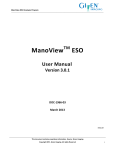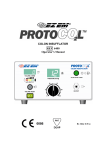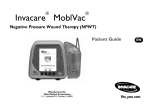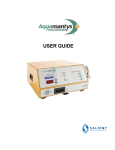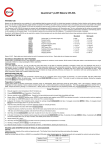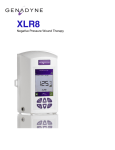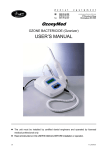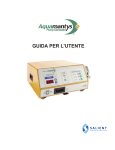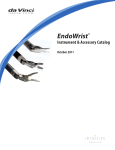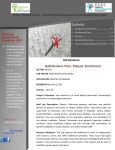Download HALO90 Ablation Catheter INSTRUCTIONS FOR USE
Transcript
HALO90 Ablation Catheter INSTRUCTIONS FOR USE CAUTION: Federal (USA) Law restricts this device to sale by or on the order of a Physician. BÂRRX Medical, Inc. 540 Oakmead Parkway, Sunnyvale, CA 94085 USA Telephone: 888-662-2779; 408-328-7310 Facsimile: 408-738-1741 INDICATED USE 90 The HALO Ablation Catheter is indicated for use in the coagulation of bleeding and non-bleeding sites in the gastrointestinal tract including but not limited to the esophagus. Indications include Esophageal Ulcers, Mallory-Weiss tears, Arteriovenous Malformations, Angiomata, Barrett’s Esophagus, Dieulafoy Lesions, and Angiodysplasia, Gastric Antral Vascular Ectasia (GAVE) and Radiation Proctitis (RP). 90 EU, Canada: The HALO Ablation Catheter is indicated for use in the coagulation of bleeding and non-bleeding sites in the gastrointestinal tract including but not limited to Barrett’s Esophagus. Sterile EO 90 HALO ABLATION CATHETER: DEVICE OVERVIEW 90 The HALO Ablation Catheter is used to deliver RF energy to tissue within the gastrointestinal tract. The catheter is provided in one size. • The device is attached to the distal end of an endoscope and is introduced under direct visualization into the esophagus. • The device is directed to the targeted gastrointestinal tissue, applied to the tissue using the endoscope, and energy delivered to the tissue. • The pivot mechanism of the ablation device enables optimal apposition of the electrode to the surface of the targeted tissue. • If any abnormalities exist that would affect the functionality of the HALO Ablation Catheter such as breaks, tears, bends or kinks, do not use. 90 90 HALO ABLATION CATHETER DIMENSIONS 90 The HALO Ablation Catheter model 90-9100 is available in one size. See Table – 1 for model specific information. Model Useable Length Electrode Length Electrode Width Endoscope Range 90-9100 160 cm 20 mm 13 mm 8.6 mm – 12.8 mm Table – 1 90 FLEX 90 or HALO Energy The HALO Ablation Catheters are referred to in this Instructions For Use as the “Ablation Catheter”. The HALO FLEX 90 or HALO Output Cable is referred to as the “Output Cable”. The Generator is referred to as the “Energy Generator”. The HALO FLEX 90 or HALO Footswitch is referred to as the “Footswitch” or “Footpedal”. HALO GENERAL WARNINGS AND PRECAUTIONS ! The safe and effective use of RF energy is highly dependent upon factors under the control of the operator. There is no substitute for 90 a properly trained endoscopy staff. It is important that the operating instructions supplied with the HALO Ablation Catheter as well as the FLEX 90 HALO and HALO Energy Generators be read, understood and followed before use. GENERAL WARNINGS • Do not use this device for any purpose other than the indicated use. • Inspect the device packaging before use and do not use device if any damage to inner pouch or device is observed. • Do not advance or retract the HALO Ablation Catheter and/or endoscope if resistance is met. • Do not store the HALO Ablation Catheter near flame or temperatures in excess of 35ºC. • Do not deliver RF energy in areas already treated with staples. The presence of metallic staples can disturb the treatment pattern and may lead to complications. 90 90 717-0015-01 Revision: D Page 1 of 7 GENERAL PRECAUTIONS • The HALO Ablation Catheter is for use with the HALO • The HALO Ablation Catheter should be used only by a physician trained in therapeutic endoscopy. • HALO Ablation Catheter must be used with concurrent endoscopic visualization. • The HALO Ablation Catheter should be used with caution in patients who present with anatomic variations of the targeted portion of the esophagus, such as a diameter that may be too large or too small to accommodate the device. Such disorders may include, but are not limited to, stricture, achalasia, and scleroderma. • The HALO Ablation Catheter should be used with endoscope sizes identified in Table - 1. Attaching a HALO Ablation Catheter to 90 endoscopes larger than the specified range could result in damage to the HALO Ablation Catheter and/or the endoscope. Attaching 90 90 a HALO Ablation Catheter to endoscopes smaller than 8.6 mm could result in the HALO Ablation Catheter slipping from the endoscope during use. 90 FLEX 90 and HALO Energy Generators only. 90 90 90 90 90 CONTRAINDICATIONS, WARNINGS AND PRECAUTIONS 90 SPECIFIC TO THE USE OF THE HALO ABLATION CATHETER FOR THE SUB-INDICATION OF BARRETT’S ESOPHAGUS CONTRAINDICATIONS • Pregnancy • Prior radiation therapy to the esophagus • Esophageal varices at risk for bleeding • Prior Heller myotomy • Eosinophilic Esophagitis WARNINGS • The following are side effects that may be expected after treatment (all transient): chest pain, dysphagia, odynophagia, throat pain and/or fever after treatment. Side effects should be managed by the physician at their discretion. • Complications observed at very low frequency include: • o mucosal laceration; o minor acute bleeding; o stricture formation requiring dilation; o major bleeding; o and transfusion secondary to major bleeding. Potential complications not observed to date include: o perforation of the stomach, esophagus, or pharynx; o surgery to correct perforation; o infection; o pleural effusion; o arrhythmia; o aspiration; o and death. • Vomiting post-treatment must be addressed by the physician, as it may result in more serious injury such as esophageal perforation, aspiration and possibly death. • Previous stricture formation within the esophagus, dilation procedures within the esophagus, erosions of the esophagus, ulceration of the esophagus, ablative procedures of the esophagus, and/or resective procedures of the esophagus may predispose patient to esophageal stricture formation after treatment with this device given the altered anatomy, physiology and wound healing characteristics inherent to these disease states and therapies. • Anti-secretory medication should be provided in a dosing regimen that fully controls GERD symptoms and heals esophageal inflammation, erosions and ulcerations prior to use of this device. In the AIM Clinical trials, high-dose proton pump inhibition (esomeprazole 40 mg bid) was provided for at least 7 days prior to and for at least one month after use of this device. Esomeprazole was reduced to 40 mg qd after healing of coagulated tissue was confirmed. Failure to provide adequate anti-secretory therapy at least 7 days before and after use of this device may lead to a higher rate of stricture formation than expected and/or persistence/recurrence of Barrett’s esophagus. • Use of this device in a patient with active esophagitis, erosions, or ulceration may lead to a higher rate of complications and should not be undertaken until such abnormalities are treated to resolution. • Failure to follow the recommended discharge instructions regarding anti-secretory medications, antacid/lidocaine, and narcotics may result in higher incidence of complications and patient pain. 717-0015-01 Revision: D Page 2 of 7 • Failure to follow the Instructions For Use regarding the introduction, positioning, and energy delivery related to the HALO Ablation Catheter may result in a higher than expected rate of complications after use of the device. • Failure to clean the Ablation Catheter electrode and the lumen of treated esophagus after the first treatment pass may result in areas of under-treatment and/or over-treatment, and could reduce effectiveness and increase risk of complications. 90 PRECAUTIONS Use of this device has not been studied in or may be more difficult, less effective, or less well-tolerated in patients with: o Barrett’s esophagus length greater than 6 cm, o age under 18 years, o esophageal stricture preventing passage of endoscope with catheter; o active esophagitis (Hetzel-Dent Grade III or IV) described as erosions or ulcerations encompassing more than 10% of distal esophagus; o history or current diagnosis of malignancy of the esophagus; o any previous ablative therapy within the esophagus (photodynamic therapy, multipolar electrical coagulation, argon plasma coagulation, laser treatment, or other); o any previous endoscopic mucosal resection within the esophagus (recent studies have allowed 2 months after EMR prior to use of this device to allow complete healing, and, have limited the extent of prior EMR to less than 2 cm length and less than 50% of esophageal lumen circumference); o any previous surgery with staples present, including fundoplication (users are cautioned regarding inflation of a balloon in the fundoplication zone as staples could potentially disrupt the wrap). Staples from previous esophageal surgery may interfere with the performance of this device and may lead to complications; o an implantable pacing device unless permission is provided by the specialist responsible for the pacing device; o dysplasia; o nodularity of the esophageal mucosa. ! FLEX 90 FLEX User Manuals for the HALO and HALO Ablation Systems are supplied with the HALO 90 and must be read and understood prior to use of the HALO Ablation Catheter. 90 and HALO Energy Generators INSTRUCTIONS FOR USE 90 SPECIFIC TO THE USE OF THE HALO ABLATION CATHETER FOR THE SUB-INDICATION OF BARRETT’S ESOPHAGUS The following is a representation of the procedural steps used for the Ablation of Intestinal Metaplasia Containing Dysplasia Trial (AIM-Dysplasia). This Guide is not meant to replace physician judgment. Procedural steps may vary by patient according to patient tolerability, anatomy, motility, or characteristics of the Barrett’s esophagus. 1. Turn power switch to the “on” position on the back of the Energy Generator (Model 1190A-115A, 1190A-230A, and Model 90-9000). 2. Connect the Footswitch (Model FLEXFS-010A and Model 90-9020) cable to the Energy Generator according to the User Manual and place the Footswitch on the floor in a position accessible to the physician. 3. Connect the Output Cable (Model FLEXCC-020A and Model 90-9010) to the front panel of the Energy Generator. 4. Remove the HALO Ablation Catheter from the packaging. Connect the Ablation Catheter electrical connector to the Output Cable and confirm that the generator recognizes the connection, by showing “Catheter Ready” in the display. Disconnect the catheter from the Output Cable and prepare for mounting on the endoscope. 5. Using sterile water irrigation thoroughly wet the HALO Ablation Catheter strap and the distal end of the endoscope. Do not use alcohol or gel lubrication. 6. Insert the distal end of the endoscope into the proximal end of the catheter strap, and then advance the endoscope into the catheter strap until the tip of the endoscope is aligned with the distal end of the strap. 7. Adjust the linear position of the endoscope so that the tip of the endoscope is aligned with the pivot point of the catheter cap. While observing the video endoscopic image on the monitor, rotate the catheter so that is appears at the 12 o’clock position. If at any time, resistance to movement of the catheter over the scope is felt, re-wet the catheter and endoscope before attempting to reposition. 8. Verify the Ablation Catheter is securely attached to the endoscope before use. 9. With the Ablation Catheter attached to the distal end of the endoscope, begin the upper endoscopy procedure. As the endoscope passes through the oral cavity, the electrode surface is contact with the tongue. As the endoscope approaches the larynx and esophageal inlet, the electrode surface is oriented anteriorly. 90 90 10. Gently introduce the tip of the Ablation Catheter posterior to the arytenoids, into the esophageal inlet, avoiding contact with the larynx. Do not use excessive force. Swallowing facilitates passage of the endoscope and Ablation Catheter. 11. Irrigate the targeted segment of the esophageal lumen with N-acetylcysteine (Mucoymyst) (1%) mixed in plain water. Do not use saline. 12. Measure and record the location of abnormal tissue to be ablated. 717-0015-01 Revision: D Page 3 of 7 13. Connect the Ablation Catheter to the Output Cable, confirming that the Energy Generator recognizes the connection, by showing “Catheter Ready” in the display. Set the Energy Generator to the following settings to achieve the desired coagulation effect of blanching and sloughing. HALOFLEX and HALO90 Energy Generator Model 1190A-115A Model 90-9000 (115V, 230V) Model 1190A-230A Catheter Model Power (Watts) Energy (J/cm2) Power Density (Watts/cm2) Energy (J/cm2) Recommended start settings for treating Barretts’s Esophagus 90-9100 104 12 40 12 Recommended range for treating Barretts’s Esophagus 90-9100 104 12 - 15 40 - 45 12 - 15 Table – 2 14. Target islands and tongues of abnormal tissue first, working proximal to distal, followed by targeting abnormal tissue in the gastroesophageal junction or cardia. 15. Rotate and linearly position the Ablation Catheter so that the targeted tissue is at 12 o’clock in the endoscope view and is just distal to the tip of the Ablation Catheter. Move the catheter to cover the targeted tissue and deflect the endoscope upward (large wheel back) confirming good contact and deflection of ablation surface. 16. Depress the RF POWER ON/OFF (blue) footswitch or RF POWER ON/OFF button to deliver energy. Without moving the Ablation Catheter, deliver a second ablation when the Energy Generator displays “Catheter Ready.” 17. Inspect for adequate ablation effect. Move on to the next segment of targeted tissue. 18. The gastroesophageal junction and cardia can be treated in a similar manner by positioning the device with the tip just proximal to the top of the gastric folds, deflecting the endoscope and catheter upward, and delivering energy. Rotate the endoscope and Ablation Catheter after each ablation set to create a circumferential treatment zone. 19. When all tissue has been treated, use irrigation and the endoscope suction to remove all coagulated tissue to provide a clean ablated surface. 20. Disconnect the Ablation Catheter from the Output Cable. Remove the endoscope and Ablation Catheter. Rinse with sterile water irrigation and clean the electrode surface with wet gauze. 21. Reintroduce the endoscope and Ablation Catheter. Reconnect the Ablation Catheter to the Output Cable. Confirm that the Energy Generator is set to the appropriate settings listed in Table - 2. 22. Repeat steps 15 through 19. 23. Disconnect the Ablation Catheter from the Output Cable. Remove the endoscope and Ablation Catheter. REPRESENTATIVE DISCHARGE INSTRUCTIONS SPECIFIC TO THE USE OF THIS DEVICE FOR THE SUB-INDICATION OF BARRETT’S ESOPHAGUS The following is a representation of the discharge instructions used for the Ablation of Intestinal Metaplasia Trial (AIM-II). These instructions are not meant to replace physician judgment. Instructions provided to the patient are the responsibility of the physician. • Maximize anti-secretory regimen (for example, esomeprazole or Nexium 40 mg twice per day for 1-3 months, followed by at least 40 mg per day thereafter). • Antacid/lidocaine mixture per oral prn. • Liquid acetaminophen with or without codeine per oral prn. 717-0015-01 Revision: D Page 4 of 7 • Anti-emetic medication per rectum prn. • Full liquid diet for 24 hours, then advancing to soft diet for 1 week. • Avoid aspirin or non-steroidal anti-inflammatory medications for 7 days (per physicians’ instructions). • Patient instructed to contact treating physician immediately for significant chest pain, difficulty swallowing, fever, bleeding, abdominal pain, difficulty breathing, vomiting or other warning signs provided by your physician. • If the patient seeks care for a digestive issue from any healthcare personnel in the 6 months following the ablation procedure, other than the treating physician, the treating physician should be consulted before any treatment is initiated. CONTRAINDICATIONS, WARNINGS AND PRECAUTIONS 90 SPECIFIC TO THE USE OF THE HALO ABLATION CATHETER FOR THE SUB-INDICATION OF BLEEDING AND NON-BLEEDING SITES IN THE GASTROINTESTINAL TRACT CONTRAINDICATIONS • Pregnancy; • Presence of gastric or colorectal ulcers; • History of anal incontinence; • Presence of anorectal fistulae; • Pelvic irradiation within the last 6 months. WARNINGS • Potential complications not observed to date include: o irritation or injury to the esophagus or anal canal; o gastric or colorectal stricture or perforation; o surgery to correct perforation; o infection; o major bleeding; o transfusion secondary to major bleeding; o aspiration; o death. • Vomiting post-treatment must be addressed by the physician, as it may result in more serious injury such as esophageal perforation, aspiration and possibly death. • Failure to clean the electrode surface after several applications may result in areas of under-treatment and/or over-treatment, and could reduce effectiveness and increase risk of complications. • Failure to discontinue platelet inhibiting agents (i.e., aspirin, clopidogrel, non-steroidal anti-inflammatory agents) and anti-thrombotic agents (i.e., heparain, warfarin) 7 days before and after treatment may lead to higher rates of intra and post-treatment bleeding, and may possibly lead to transfusion therapy, endoscopic therapy for hemostasis, surgery, or even death. PRECAUTIONS • Use of this device has not been studied in or may be more difficult, less effective, or less well-tolerated in patients with: o age under 18 years; o esophageal or colorectal stricture impeding passage of endoscope with Ablation Catheter; o history or current diagnosis of malignancy of the stomach, colon or rectum; o any previous coagulative therapy within the stomach, colon or rectum (depending on the intended site of device application multipolar electrical coagulation, argon plasma coagulation, laser treatment, or other); o any previous gastric or colorectal surgery with staples present as the staples may interfere with the performance of the device and lead to complications; o and an implantable pacing device, unless permission is provided by the specialist responsible for the pacing device. ! FLEX 90 FLEX User Manuals for the HALO and HALO Ablation Systems are supplied with the HALO 90 and must be read and understood prior to use of the HALO Ablation Catheter. 717-0015-01 Revision: D 90 and HALO Energy Generators Page 5 of 7 INSTRUCTIONS FOR USE 90 SPECIFIC TO THE USE OF THE HALO ABLATION CATHETER FOR THE SUB-INDICATION OF BLEEDING AND NON-BLEEDING SITES IN THE GASTROINTESTINAL TRACT This Guide is not meant to replace physician judgment. Procedural steps may vary by patient according to patient tolerability, anatomy, motility, or characteristics of the underlying disease. 90 1. Turn power switch to the “on” position on the back of the HALO Energy Generator (Model 1190A-115A, 1190A-230A, or 90-9000). 2. Connect the Footswitch (Model FLEXFS-010A or Model 90-9020) cable to the Energy Generator according to the User Manual and place the Footswitch on the floor in a position accessible to the physician. 3. Connect the Output Cable (Model FLEXCC-020A or Model 90-9010) to the front panel of the Energy Generator. Remove the HALO Ablation Catheter from the packaging. Connect the Ablation Catheter electrical connector to the Output Cable and confirm that the Energy Generator recognizes the connection, by showing “Catheter Ready” in the display. Disconnect the catheter from the Output Cable and prepare for mounting on the endoscope. 4. Using sterile water irrigation thoroughly wet the Ablation Catheter strap and the distal end of the endoscope. Do not use alcohol or gel lubrication. 5. Insert the distal end of the endoscope into the proximal end of the catheter strap, and then advance the endoscope into the catheter strap until the tip of the endoscope is aligned with the distal end of the strap. 6. While observing the video endoscopic image on the monitor, rotate the Ablation Catheter so that is appears at the 12 o’clock or 6 o’clock position as needed. If at any time, resistance to movement of the catheter over the scope is felt, re-wet the Ablation Catheter and endoscope before attempting to reposition. 7. Verify the Ablation Catheter is securely attached to the endoscope before use. 8. With the Ablation Catheter attached to the distal end of the endoscope, begin the procedure. 90 For esophageal introduction: As the endoscope passes through the oral cavity, the electrode surface is in contact with the tongue. As the endoscope approaches the larynx and esophageal inlet, the electrode surface is oriented anteriorly. Gently introduce the tip of the Ablation Catheter posterior to the arytenoids, into the esophageal inlet, avoiding contact with the larynx. Do not use excessive force. Swallowing facilitates passage of the endoscope and Ablation Catheter. For rectal introduction: Gently use a finger to guide the introduction of the endoscope and Ablation Catheter through the anal canal. 9. Areas of potential or active bleeding are identified. 10. Connect the Ablation Catheter to the Output Cable, confirming that the Energy Generator recognizes the connection, by showing 2 2 2 “Catheter Ready” in the display. Set the Energy Generator to appropriate settings (12 J/cm to 15 J/cm and 40 W/cm or 104W) to achieve the desired coagulation effect. 11. Position the catheter to contact the targeted tissue and deflect the endoscope to upward to establish firm contact. 12. In the rectum, the physician may retroflex the endoscope with the Ablation Catheter in the 6 o’clock position to reach targeted tissue adjacent to the dentate line. 13. Depress the blue footpedal to deliver energy. Without moving the Ablation Catheter, deliver successive ablations when the energy generator displays “Ready”. Commonly, a total of 2 ablations are delivered per segment in the colon and rectum and 4 ablations in the stomach. Inspect for adequate coagulation effect. Move on to the next segment of targeted tissue. 14. Do not remove coagulum from the treatment zones as this may induce bleeding and lessen the hemostatic effect. 15. Typically, the Ablation Catheter and endoscope are removed and cleaned after 8 energy applications in order to provide a clean and effective electrode surface for subsequent areas. 16. Disconnect the Ablation Catheter from the Output Cable. Remove the endoscope and Ablation Catheter. Rinse with sterile water irrigation and clean the electrode surface with a wet gauze. 17. Reintroduce the endoscope and Ablation Catheter. Reconnect the Ablation Catheter to the Output Cable. Repeat steps 8 through 16. 18. Remove the endoscope and Ablation Catheter. REPRESENTATIVE DISCHARGE INSTRUCTIONS 90 SPECIFIC TO THE USE OF THE HALO ABLATION CATHETER FOR THE SUB-INDICATION OF COAGULATION OF GASTROINTESTINAL TRACT BLEEDING The following is a representation of the discharge instructions currently used by physicians. These instructions are not meant to replace physician judgment. Instructions provided to the patient are the responsibility of the physician. • Acetaminophen with or without codeine prn. • Anti-emetic medication prn. • Full liquid diet for 24 hours, then advancing to soft diet for 1 week following gastric application of the Ablation Catheter. 717-0015-01 Revision: D Page 6 of 7 • High fiber diet and stool softeners prn for 1 week following colorectal application of the Ablation Catheter. • Avoid aspirin or non-steroidal anti-inflammatory medications for 7 days (per physicians’ instructions). • Patient instructed to contact treating physician immediately for fever, bleeding, abdominal or pelvic pain, difficulty breathing, vomiting or other warning signs provided by your physician. • If the patient seeks care for a digestive issue from any healthcare personnel in the 6 months following the coagulation procedure, other than the treating physician, the treating physician should be consulted before any treatment is initiated. LABELING SYMBOLS Attention: consult accompanying documents ! This product contains no detectable latex. This is a Single-Use device. DISPOSAL OF USED PRODUCT Dispose of used catheters in accordance with all government regulations. 0543 AUTHORIZED EUROPEAN REPRESENTATIVE: WMDE Bergerweg 18 6085 AT Horn The Netherlands 717-0015-01 Revision: D Page 7 of 7










